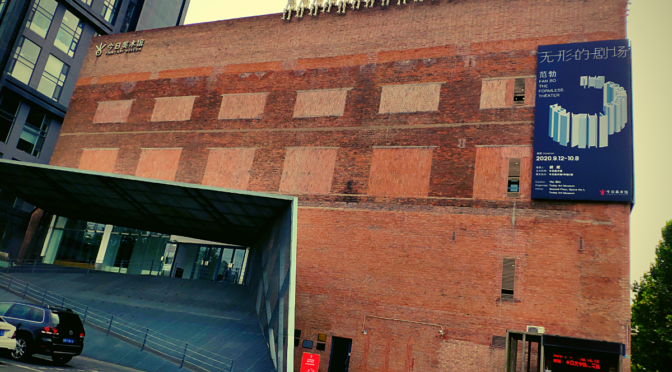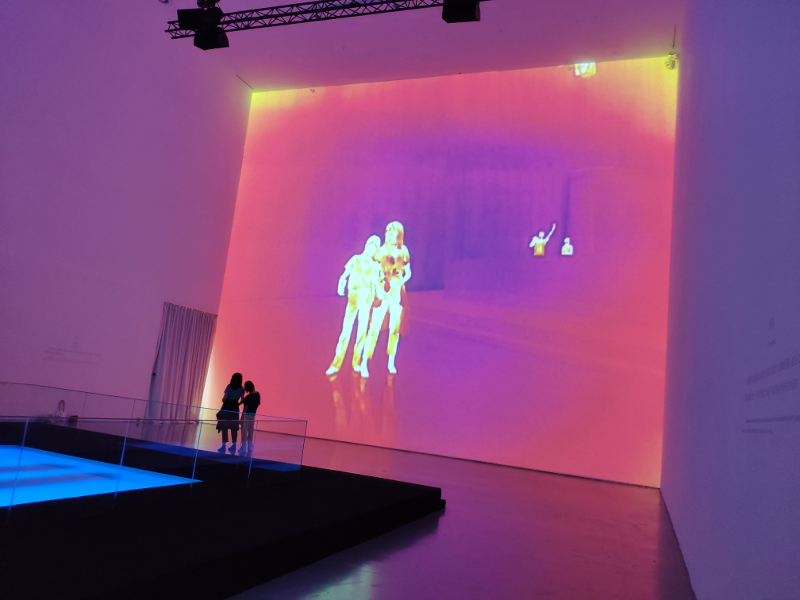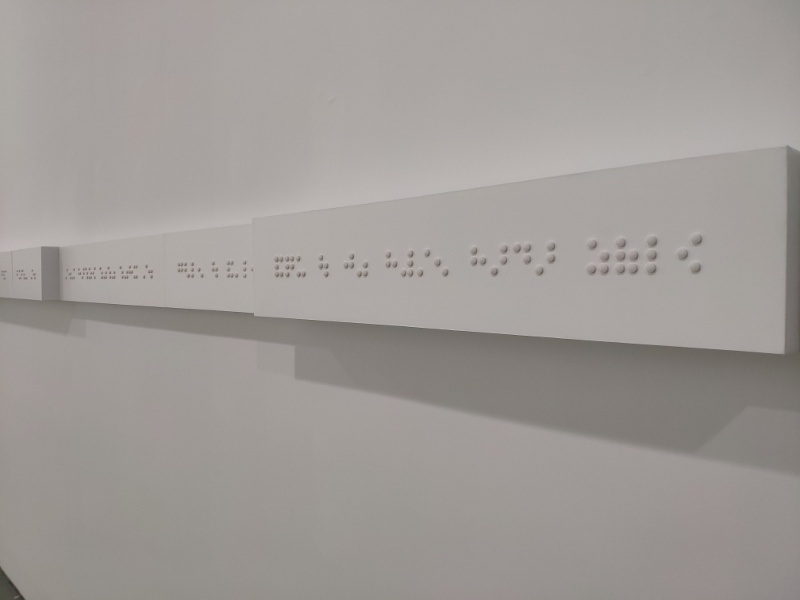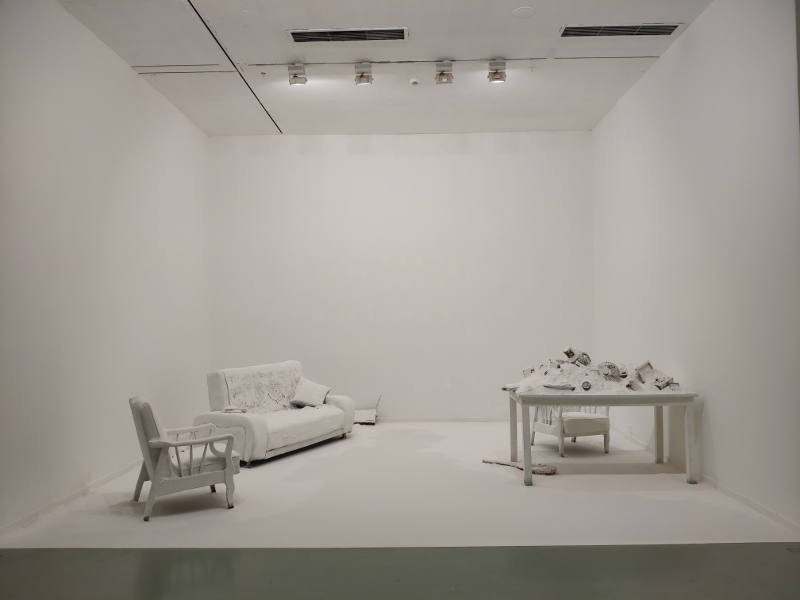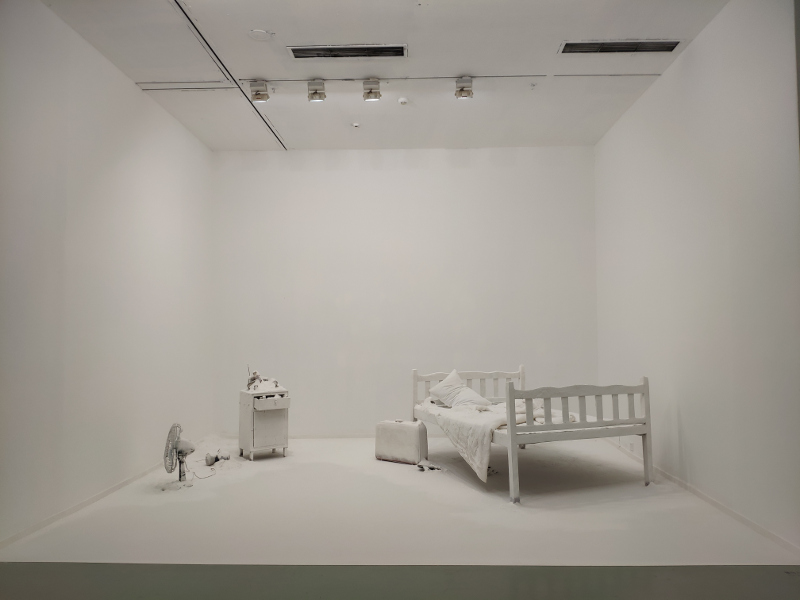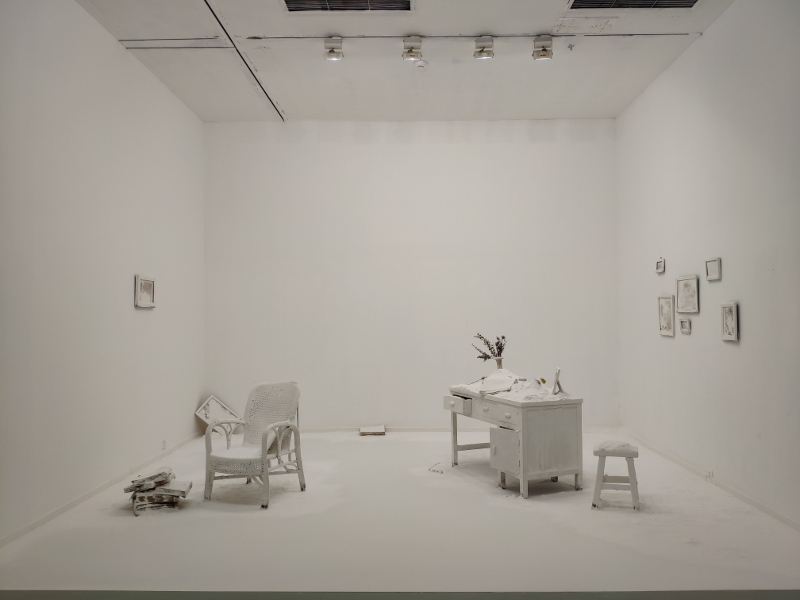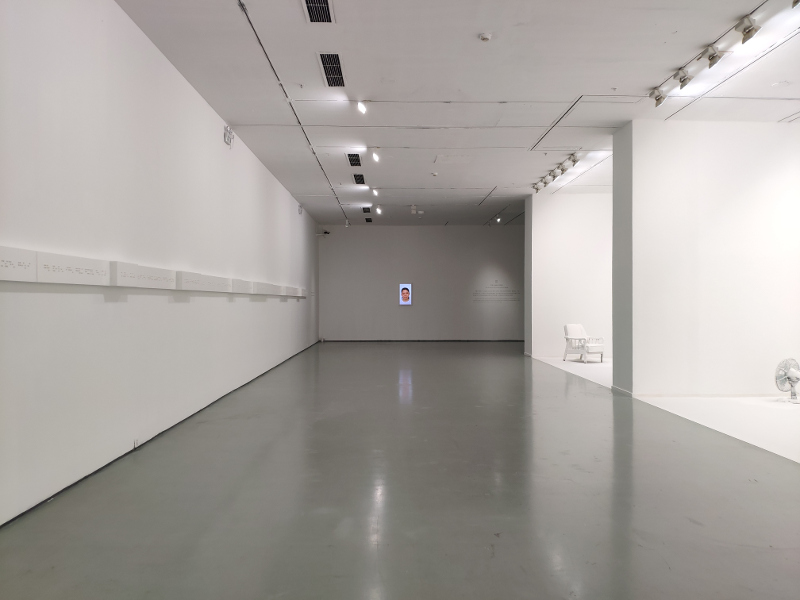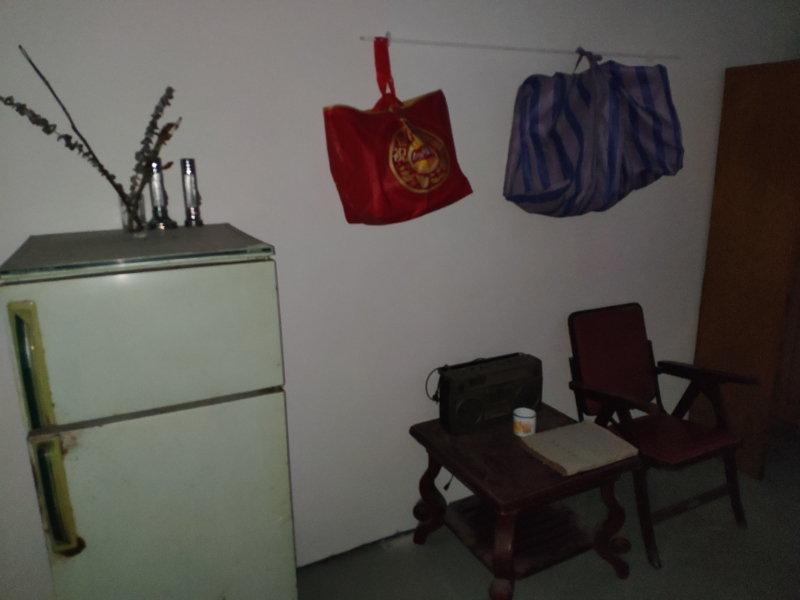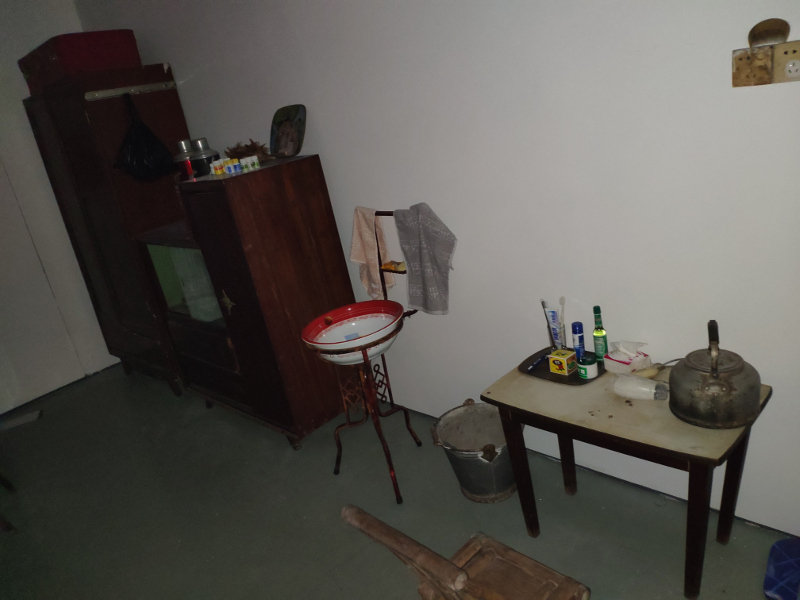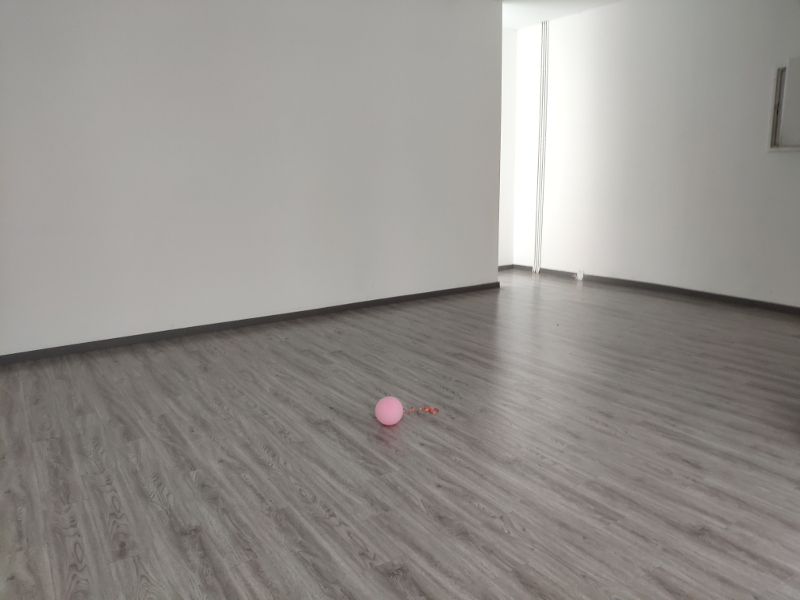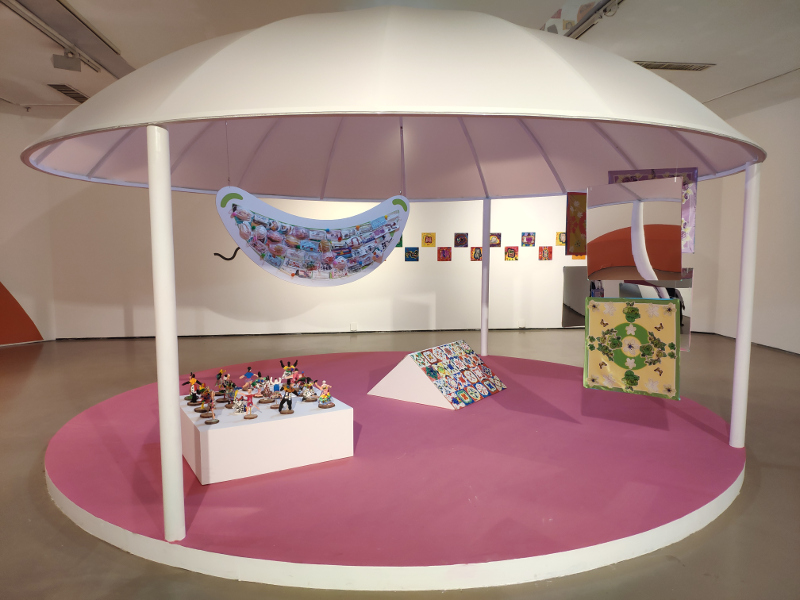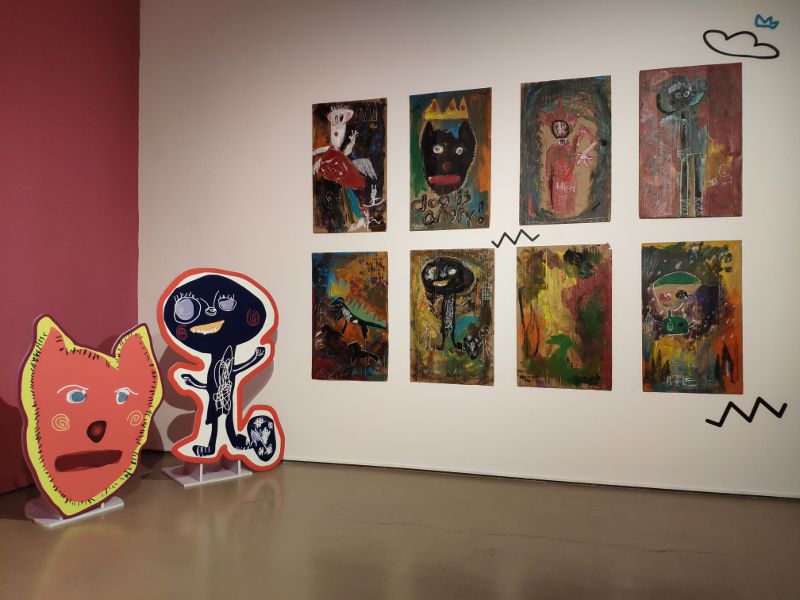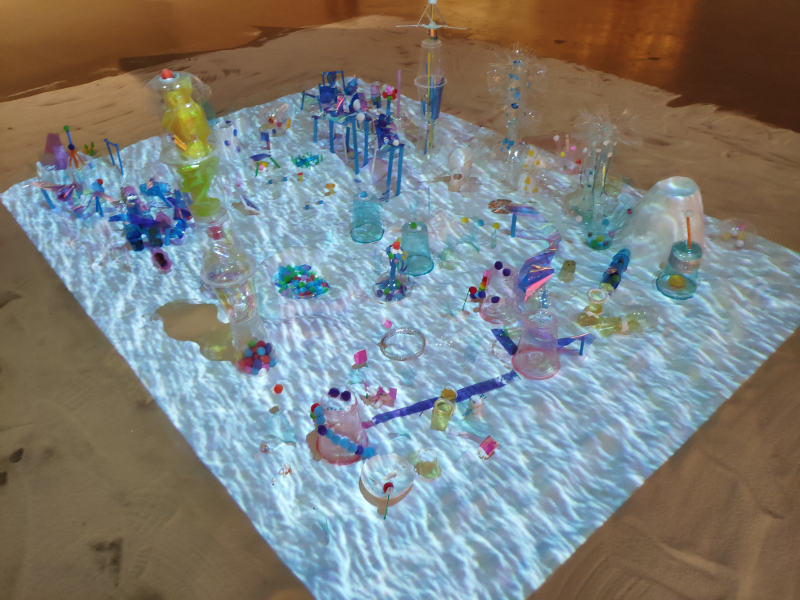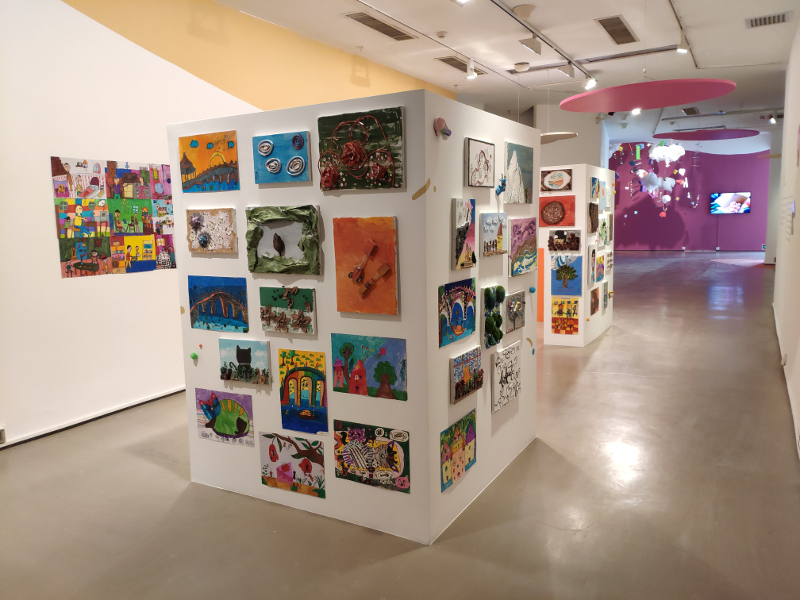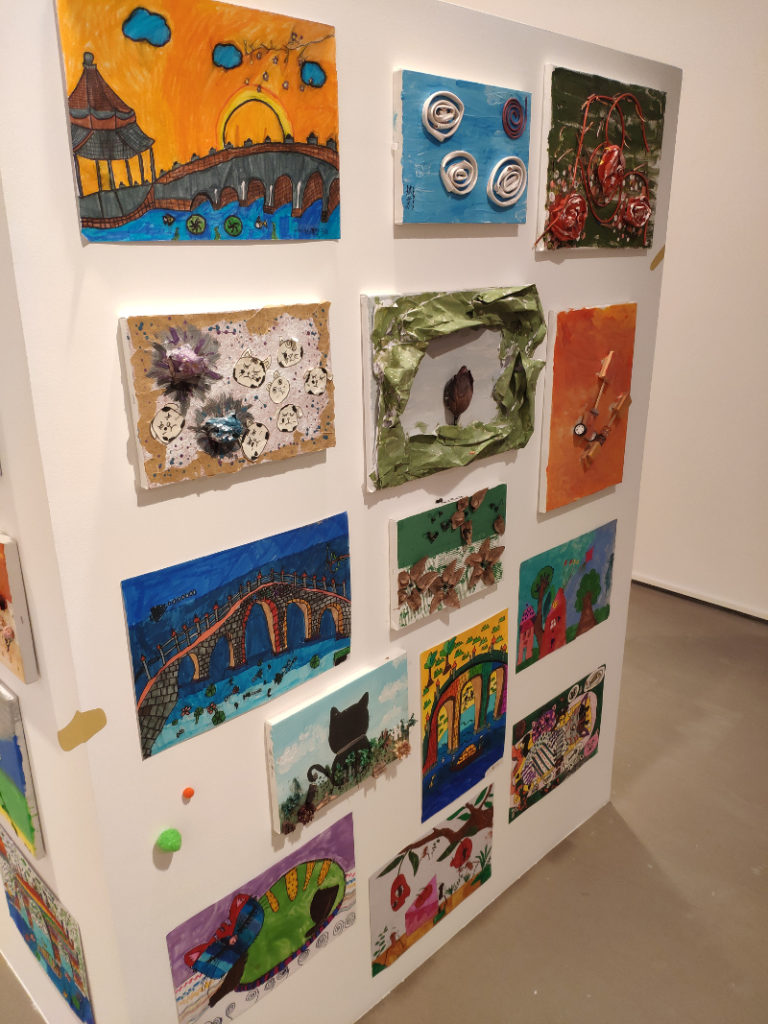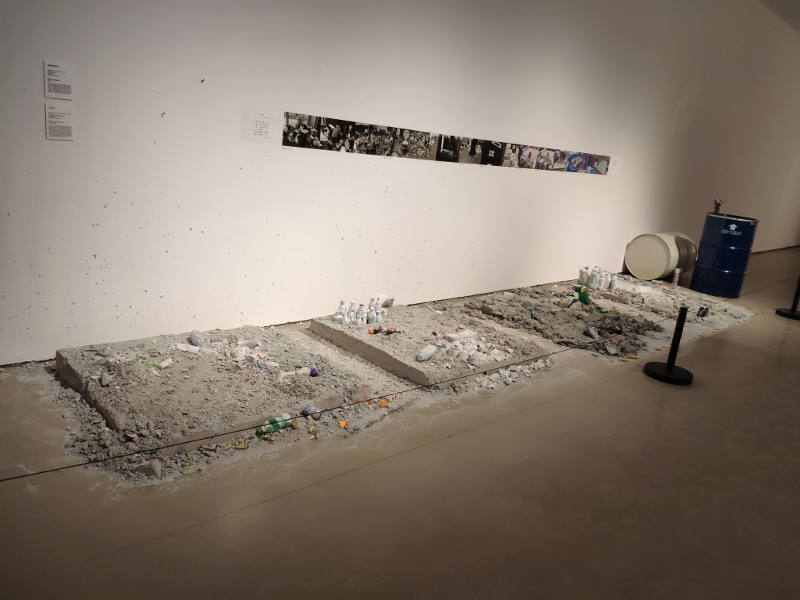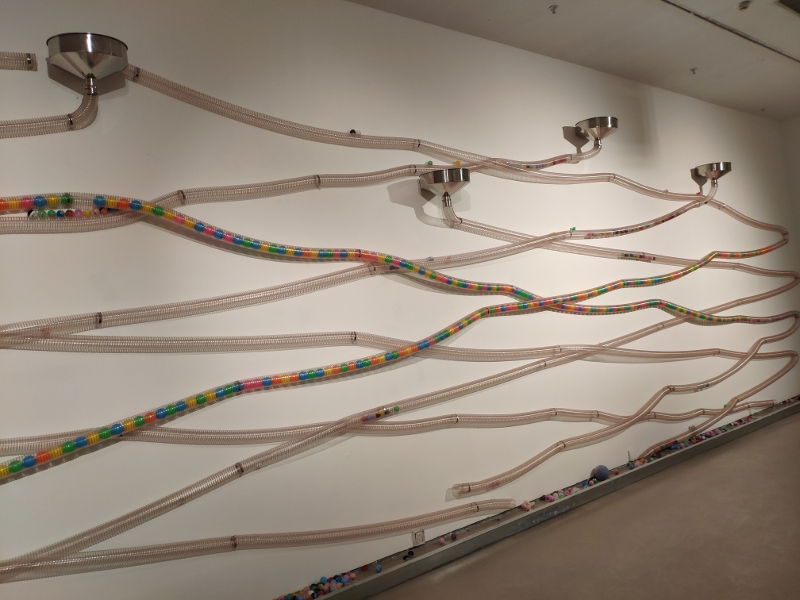Is there anything near you that people have talked about or that you have meant to go see but, since it’s so close, you just never get around to doing it? Well, for me, that’s the Today Art Museum in Shuangjing District in Beijing.
The Today Art Museum was founded was Zhang Baoquan as a place to display contemporary art. I had heard once that he had some connection with big business in China but all I could find online is that he works mostly in the real estate sector. That makes sense since the place he chose, Shuangjing District in the Chaoyang District of Beijing, is kind of a wealthy area. Or at least the properties are valued quite high.
From a distance you probably wouldn’t see it as the museum building itself is dwarfed by the tall apartment blocks surrounding it, notably the Pingguo North community. The whole area is known as one of the art districts of Beijing, but it considered far more upscale than the 798 district to the north, wherein old warehouses and factories have been turned into art galleries and cafes. Pingguo, instead, hosts the Today Art Museum with a revolving set of exhibitions which make the tail end of the community. Moving east away from the museum would take you through the Pingguo North community of cafes, tailors, shops and one or two galleries, the Plan B pub, and ends on the other side of the compound with a collection of art institutes and schools. The only place I’ve been is to Plan B because they’re open late and have Western pub food. Oh, and they play sports on TV.
But the Museum itself has always been a place that I said I’d go and so, with my new desire to see something Beijing- or China-related over the next year, this was one of the easier choices to make.
The Museum is actually comprised of three or four buildings, the main building, Building 1, houses one display, Building 2 is currently hosting a Bob Dylan exhibit, and Building 3 is currently hosting an exhibit titled “Kid Power” that encourages children’s creativity. A cafe and bookshop occupy the back of Building 1 and had a few people inside it.
Outside the Building
You don’t have to buy a ticket to see some of the larger displays since there are several on display outside of the buildings themselves. Some of the most obvious examples include the Portrait of Shisheng by Yue Minjun which stands in the parking lot outside of the main building. This display is a collection of bronze sculptures that depict a man in several states of comical facial expressions. And if you’ve ever been to Vancouver’s English Bay you’d see a similar installation, but that one is titled “A-maze-ing Laughter”., also done by Yue Minjun. Apparently he belongs to the “Cynical Realism” school of contemporary art. I never knew such a thing existed.
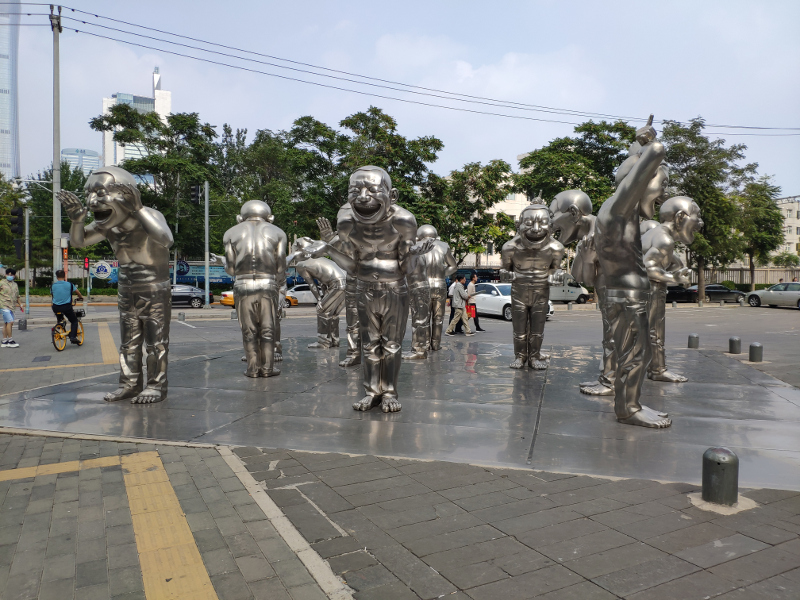
If you avoid going into the building itself you can walk around to the back of the building and most likely see the next big installation: pigs at a dining table. I’m not sure if this sculpture is some sort o commentary on the Last Supper of Jesus or some other social commentary, but it’s big enough that you don’t miss it. This work is titled The Grand Banquet and, knowing the name, suggests more of an Orwellian overtone than religious. The installation is by Lv Shun.
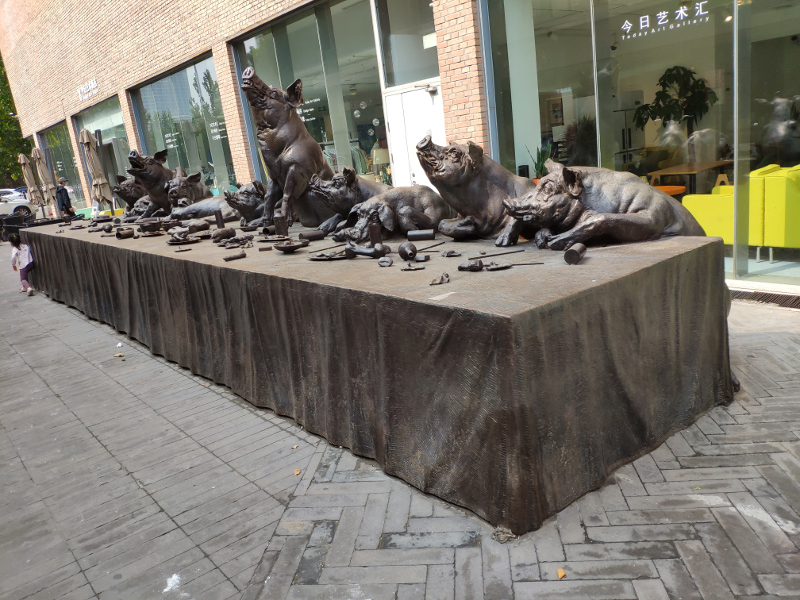
If you look up towards Building 2 across the cafe, you’ll see another installation stand out: that of a large, red dinosaur in a cage. But I couldn’t find out who made it. If you do, let me know.
If you head through the alleyway that the big red dinosaur overlooks (and in which The Grand Banquet sits) and begin to make your way through the Pingguo North Community, you’ll come across the work Materialism by Wang Guangyi, one of the oldest contemporary works the museum has in its possession.
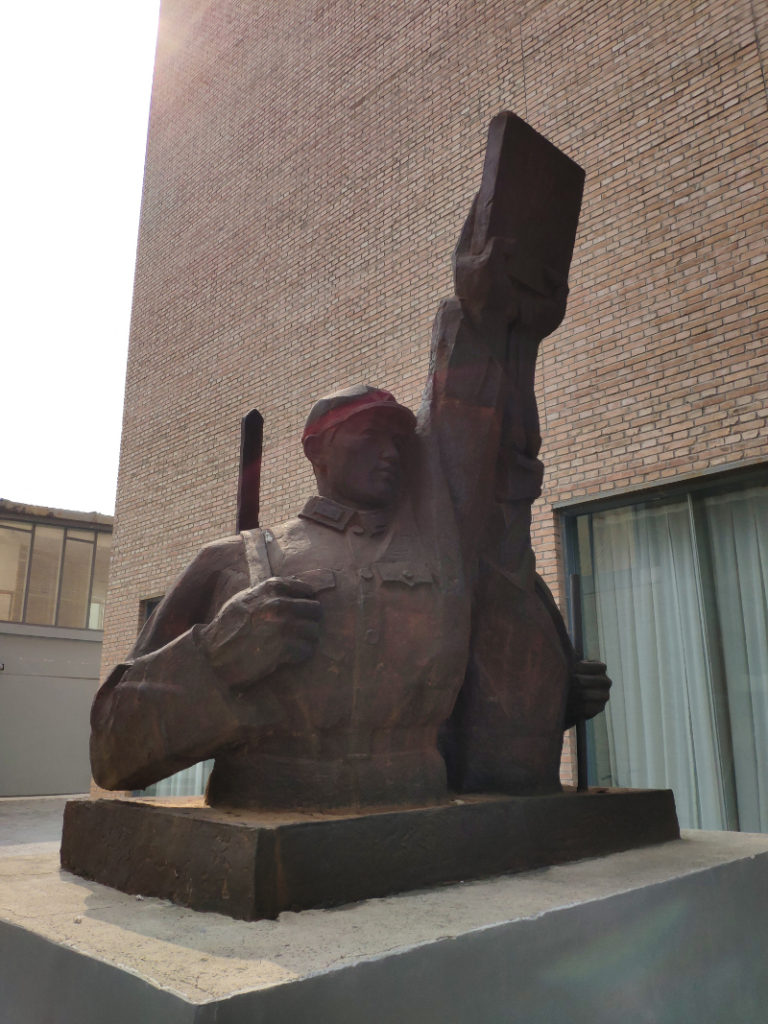
But those sculptures and installations I’d seen dozens of times having walked through the Pingguo complex on a variety of occasions. I’d never actually been inside of the museum itself and I wanted to see what was there and, most importantly, if it was worth it. Although people had talked about the Bob Dylan exhibit, I figured I’d heard his stuff before and I didn’t feel the need to look at a bunch of memorabilia about the guy. I did take a picture of the drum set in the window, but I’m not sure why it was there. (Oh, and the entrance ticket to the exhibit was separate and cost 118 RMB.)
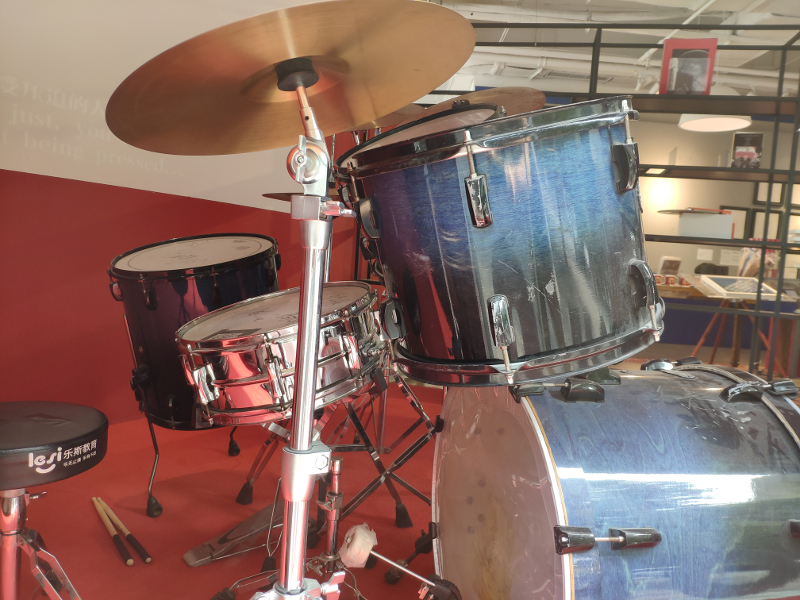
Building 1
It was Building 1 that I wanted to go inside, the actual museum. And so that’s where we went. The website said the entrance ticket would only be 20 RMB but if we could wait until the first Saturday of the month, then it would be free. Me, in my ambition to do something, decided we’d pay the entrance ticket and get it over with already.
Then we’d see why we were one of two couples in the museum.
We were the only couple walking up the slanted stairway leading into the museum and, once inside, were told the admission price was 40 RMB but that we could go to both Building 1 and Building 3. Fine, we’ll do it.
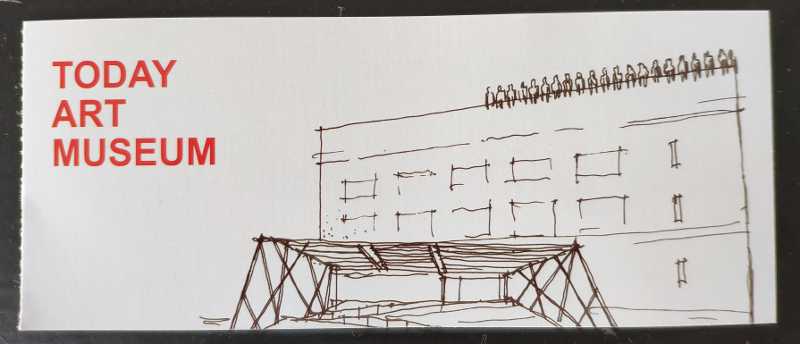
I would like to think that even if I had read the description a little bit closer, and noted how brief it was, that I wouldn’t have been surprised at the outcome of the visit. My partner wasn’t much of an art gallery person at all and this visit would only cement the reason why she usually does not go to such things.
The exhibit that was currently on display is known as “The Formless Theater” by Fan Bo and is a commentary of life during the pandemic. Or, as the artist puts it, the theater of life during the pandemic. Had I looked at the information card before the exhibit, I might have known what to expect but, as with many things, I like to go in and see for myself rather than be told what I’m seeing. And so we did.
In through the curtains we go and into the first showroom which hosts two massive screens on each end with another pool-like screen on the floor. The floor’s screen was static, darkish blue with a black figure of some sort in the middle of it. The screens on either end, however, showed images from thermal cameras, no doubt some sort of reference to the thermal cameras used to detect the temperature of people passing through airports and train stations and the like.
This was neat as one camera was on the outside of the building facing the parking lot, which took up one screen, while the other camera was facing us, the visitors. The second camera was situated in the corner in such a nondescript location that it was tough to tell where it was actually located. There was another couple already closer to the camera so their images on the screen were much bigger than ours. So what did I do? Try to give them bunny ears.
So, as the one couple exited and we moved closer to the camera we danced around a little bit in front of it and took pictures or ourselves on the screen. We were close, then far, then close again.
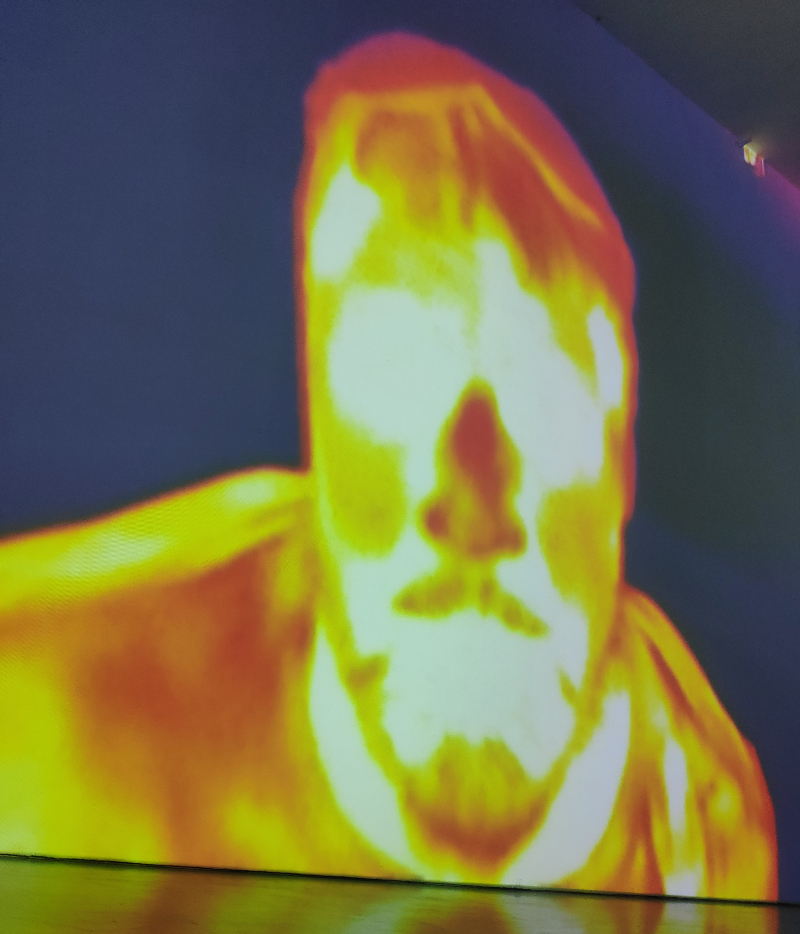
Not really knowing what to do about the image in the middle of the floor we didn’t even bother walking around it. Maybe we should have, if only to justify the cost of the ticket. So we moved on to the next room.
Upon entering the second room through the curtains we could hear a girl speaking. She was speaking in Chinese and was talking about her experience being blind. That TV screen was on the wall as we walked in, facing the large open room.
The rest of the space was occupied with a braille inscription running along one wall away from the TV screen and, opposite the inscription, three separate, life-sized “scenes” all coated in white powder. The braille inscription, I think, was also written in Chinese and displayed on a piece of paper beside the inscription. I figured the inscription had something to do with the blind girl talking on the TV.
The life-sized scenes each depicted some snapshot of life and were all heavily coated with white paint and powder. The first scene had a a comfy chair and sofa facing another comfy chair set up beside a table full of junk.
The second scene was a bedroom, sparsely filled, a bed with no mattress, a piece of luggage right beside the bed, then a nightstand a few feet away with a mound of junk on top, and then a fan pointed at the wall, away from the bed.
The third and final scene was an office of some sort with a chair and a desk but the chair wasn’t facing the desk and was played a few feet away, closer to the wall than to the desk, and had a stacks of books by its feet. Some picture frames hung on the wall but you couldn’t really see what was in them, while the desk had a fake flower in a pot and another pile of stuff scattered all over it. A pair of glasses lay on the floor beside the desk and a stool stood next to the desk.
Again, all of this was coated in heavy white paint and powder and, as you can tell by my own description, the scenes seem to get busier as you went along. Maybe that was the artist’s intent? I finally read the description of the scenes at the fa end of the exhibit but it seemed pretty obvious: these were post-apocalyptic scenes of the things people would leave behind.
This took me all of two minutes to walk through and observe but, given the cost of the ticket, figured I should linger a little while longer. The other couple took pictures and then exited into the next room. I waited for my partner to read all of the descriptions.
Once done, a guy who had been on his cell phone until we made it clear that we were moving on to the next room, warned us that the next room was dark and that we needed to watch our step.
This seemed a little bit freaky, to tell the truth. Was this a haunted house installation all of a sudden?
Not exactly, but it did give us a surprise.
What awaited was a dark room but, every twelve seconds or so we would hear a loud pop and a light would flash on and off for a brief second. How did I know it was twelve seconds? Because the timer on the ceiling had clearly visible and bright red numbers. This helped as it took a bit of the spook out of the installation.
So what did we see when the lights came on?
In short, the typical layout of a Chinese home. There was the old fridge from years ago, the massive canteen-thermoses that everybody has, a porcelain wash basin atop a set of metallic legs in front of a small mirror. The typical vinyl luggage bag that every family has two or three of, a few chairs, some dressers, a tea kettle with Longjin green tea (really nice tea). There were flashlights atop the fridge towards the exit of the installation but they didn’t work, almost as if to say: go with the light you have. So we did and turned on our cell phone flashlights to have a look around while the light kept popping on and off.
And after about five minutes in that room, we left. And that’s when we were surprised to find out that the exhibition was over.
That’s it? We even checked behind the curtains that covered the walls leading towards the front entrance. Three exhibits? Granted, they were massive, but that’s it? 40 RMB?
“That’s why I don’t come to these things,” my girlfriend said. She had a point.
But we weren’t done just yet. We could go see the children’s exhibition in Building 3. We figured we should since we paid the ticket.
We didn’t exactly know where the next exhibit was despite following the map but did come across a potential exhibit by way of an empty space:
We’re not sure if this was deliberate or not but it seemed to fit the description of contemporary art. Looking around we noticed there was one large window facing the street. Interesting. What is a person to do in a modern art gallery given such a canvas?
So I posed for the people outside.
I struck a pose as if in mid-movement and held it as long as I could, like those human statues. They no doubt have better techniques to keep their eyes from tearing up or going all blurry. I had a few people take a picture or two before a couple of girls started taking a video, at least I think they did because they held the camera still for a while. A minute later I couldn’t hold the pose any more so broke out into a smile and a wave and moved on. They laughed.
Building 3
Performance art finished for the day, we found Building 3 with the kids’ exhibition and, dare I say it, it was actually interesting and made up for the 40 RMB we spent.
The exhibit was called “Kid Power” and was meant to encouraged children to be creative. There were a few different parts to the exhibit, most likely grouped by age. They also had a short documentary on the school students who partook in the exhibit but I forget the name of their school.
There was a lot of painted pictures, some with crayons or coloured pencils. Other works of art used different materials either to enhance an image or to create an impressionistic piece. Most were the size of a regular piece of paper but there were some larger art works as well.
One part of the exhibit had a tent situated underneath a collection of pictures suspended from tree branches above. It gave the look of a forest and each picture was done on a transparent plastic sheet so it didn’t block out any of the others.
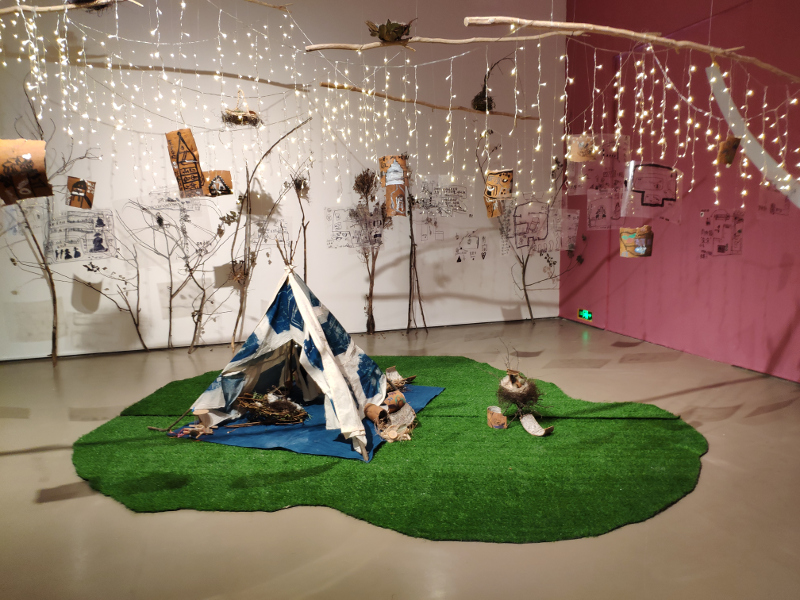
Another part of the installation consisted of two cubes covered in paintings and other creations. Yet another had vines overhanging a sand pit with several self-made objects placed it the center and illuminated by a wavy light blue light. One little girl in attendance with her parents took to playing with the fine white sand which seemed to make sense: this installation is still interactive. Others had drawn smilies and so I land down my hands and left them behind along with a smiley face.
A second floor was a set of larger installations and more of a cohesive effort than the individual paintings. Coming up the stairs we were greeted with a cross-wired fence decorated with a series of small pouches that made up characters 你好!艺术家 (Ni hao, yi shu jia) which means “Hello Artists!” The documentary playing on repeat indicated that this fence was taken from the school that participated in the construction of this installation but I didn’t get to see what the pouches were made of.
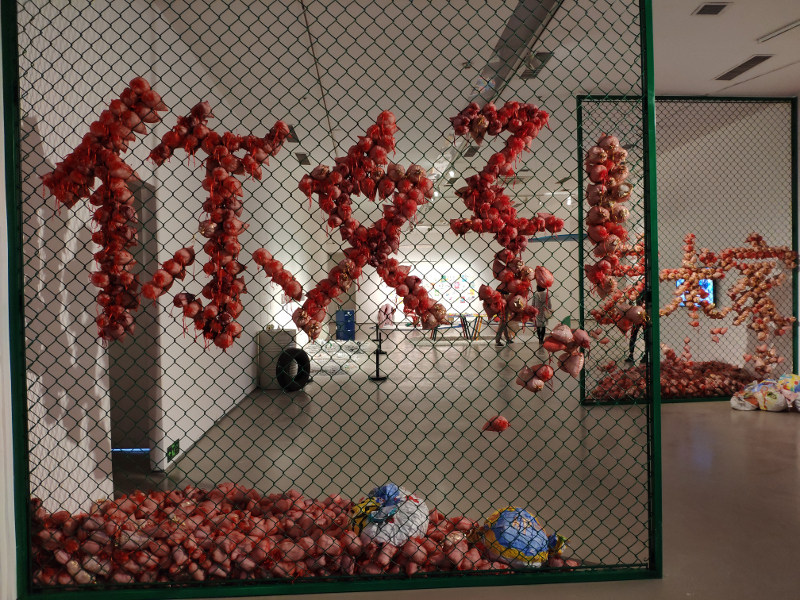
Behind the fence were a few more large pieces done by the students: a series of stone slabs that seemed to be left over construction materials; a couple of tables with designs made up of small, coloured rocks; one wall was occupied by a pipe system that seemed to allow you to throw a ball into a container and watch it roll through but the balls didn’t seemed to get stuck more often than roll.
Finally, there was one section of the floor dedicated to a set of plush chairs with stuffed arms and hands wrapped around them. The paintings behind them, all done by children, showed instructions on how to build a “hugging chair”. Some were rather creative, suggesting to use bat wings, others were a little more simple using elongated arms to wrap around everybody in the family.
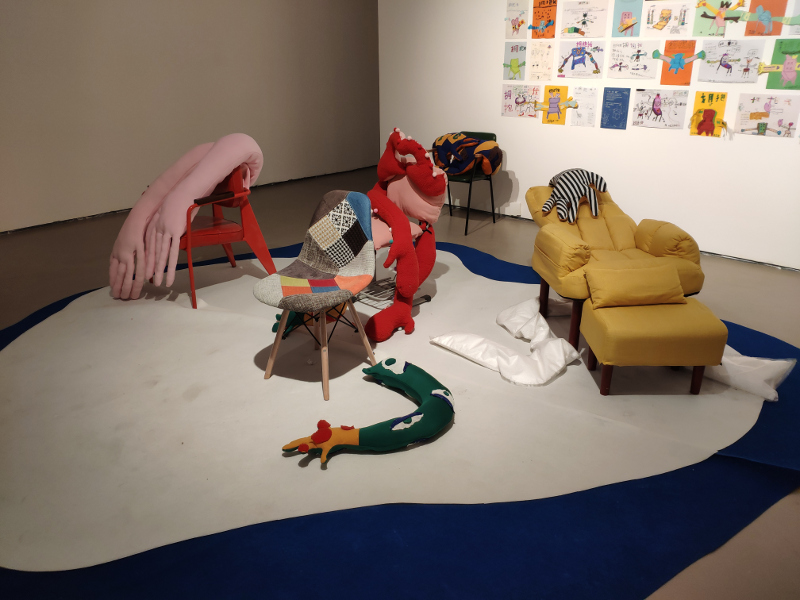
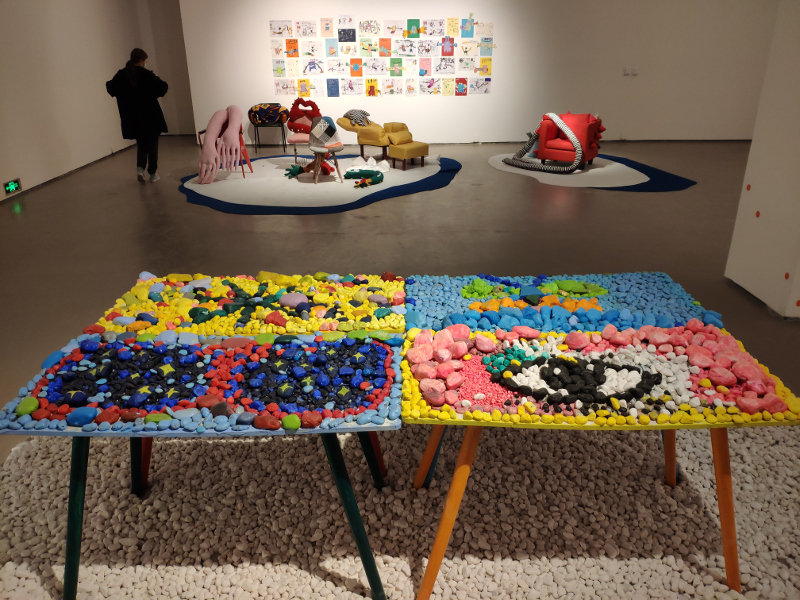
Finally, one last section of the upper floor that overlooked some of the display on the first floor was a place where kids (or anybody who wanted to get their 40 RMB’s worth) could draw. There was a mural on one wall that kids could colour in, and one not-child patron took the opportunity to do so. We saw the markers and, thinking we’d paid for it, outlined our hands and took the papers with us. There! At least we got some paper out of it!
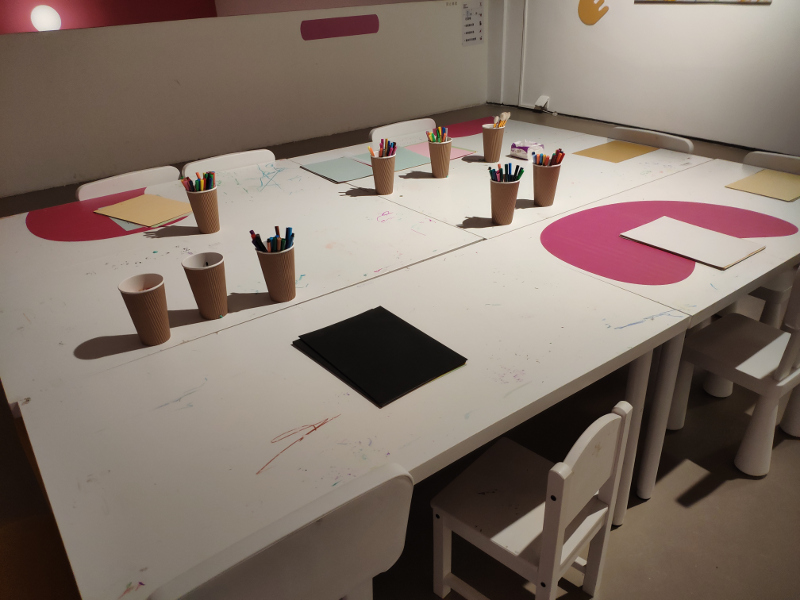
If I had to tell you whether or not to go, I’d say go if only to see the children’s works. It was neat to see how they depicted people and how even they struggled with the Chinese characters. Many of the paintings had Chinese characters interspersed with pinyin for the words they didn’t yet know how to draw. Quite a few showed some adept creative talent and sort of explains why so many of these kids grow up to be quite good artists even when it’s not their major.
And so, with that, we ended our visit to the Today Art Museum, having visited a “life after pandemic” exhibit followed by our own performance art and then an exhibit made up of children’s artwork.
